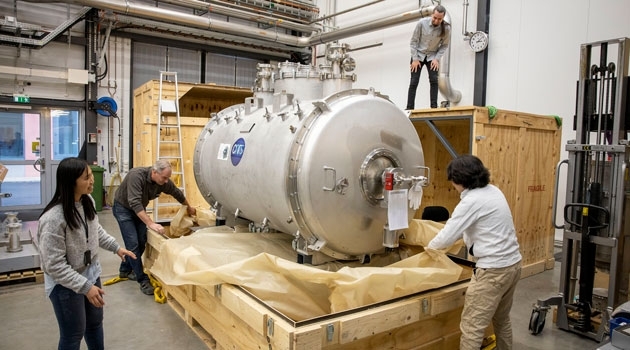Component testing for the EES facility can begin
The first modules have arrived and work can now begin. Uppsala University’s FREIA Laboratory will test whether the new accelerator modules for the large accelerator at European Spallation Source (EES) in Lund can really withstand the enormous loads that will be exposed to.
Researchers, engineers and technicians work at FREIA Laboratory to develop and test equipment needed for experiments at large research facilities like CERN, the particle physics laboratory in Switzerland, the MAX IV synchrotron light facility, and the already noted ESS accelerator in Lund.
The European Spallation Source (EES) facility is estimated to be ready for its first experiment in 2023. The facility will be the world’s most powerful neutron-source, and the 13 accelerator modules being tested by FREIA are specially built to be included in the accelerator, which will produce the neutrons.
Can only be tested here
the Department of Physics and Astronomy.
Photo: Mikael Wallerstedt
The accelerator modules, which more precisely are called superconducting accelerating cavity cryomodules, are so complex that they can be tested only here in FREIA Laboratory. They must be superconducting to accelerate the large amounts of protons needed to create ESS high neutron flows.
“In a superconductor, the electrons pair up in a way that nearly eliminates any electrical resistance, and very high electrical currents can be conducted. This is a very rare state but is possible in certain materials and at very low temperatures,” explains Olof Karis, professor and head of department at the Department of Physics and Astronomy.
And it must be cold. Very cold. The components being tested at FREIA must be cooled to −270 °C to reach the super-conductive state. This is done with liquid helium from the laboratory’s cryo facility.
“We will subject these components to incredibly intense high-frequency radio pulses. When the pulse arrives, we know that it will deform the entire accelerator component. And it must withstand this time and again.”
Maintaining the right “tone”
In addition to having to withstand a pulse equalling 5.5 million volts, the component must oscillate with the right frequency. When it is exposed to the pulse, it is expected to work as a resonance chamber in a musical instrument and maintain the right “tone” in the oscillation. If it is “out of tune”, it will not work in the accelerator.
At FREIA, we have been looking forward to starting this work.
“We are well prepared to conduct the tests. The people who are nervous are the builders of the accelerator modules. We have been ready for three years but there have been delays in other parts of the process”, says Olof Karis.
Linda Koffmar
The FREIA Laboratory
- The FREIA Laboratory conducts research on beam physics and light generation with charged particles, accelerator technology and instrumentation.
- The laboratory has a highly qualified team of over 30 researchers, engineers, PhD students and postdocs.
- The name FREIA is an acronym for Facility for Research Instrumentation and Accelerator Development. The FREIA Laboratory was founded in 2011 and the experimental hall is situated next to the Ångström Laboratory.

